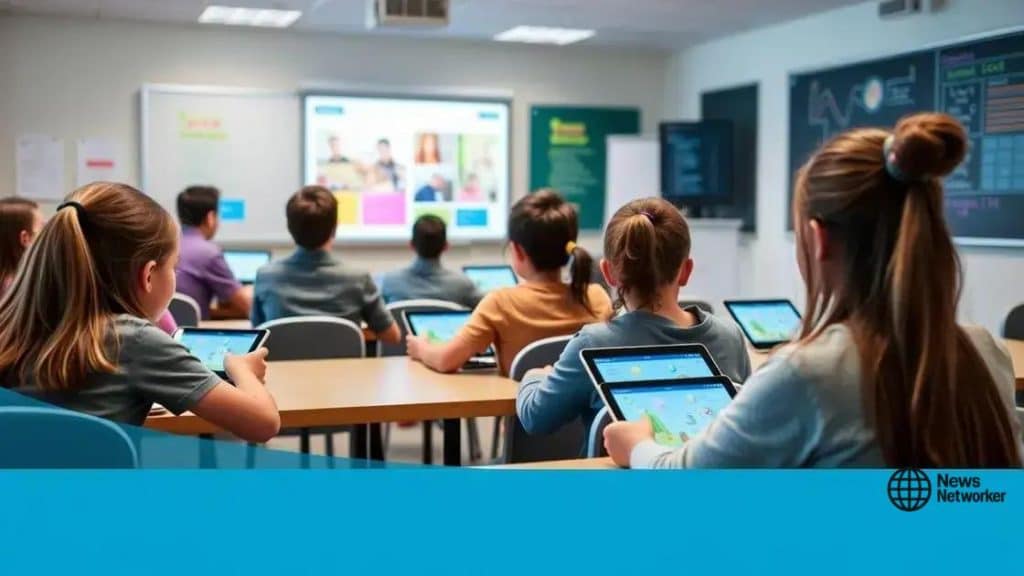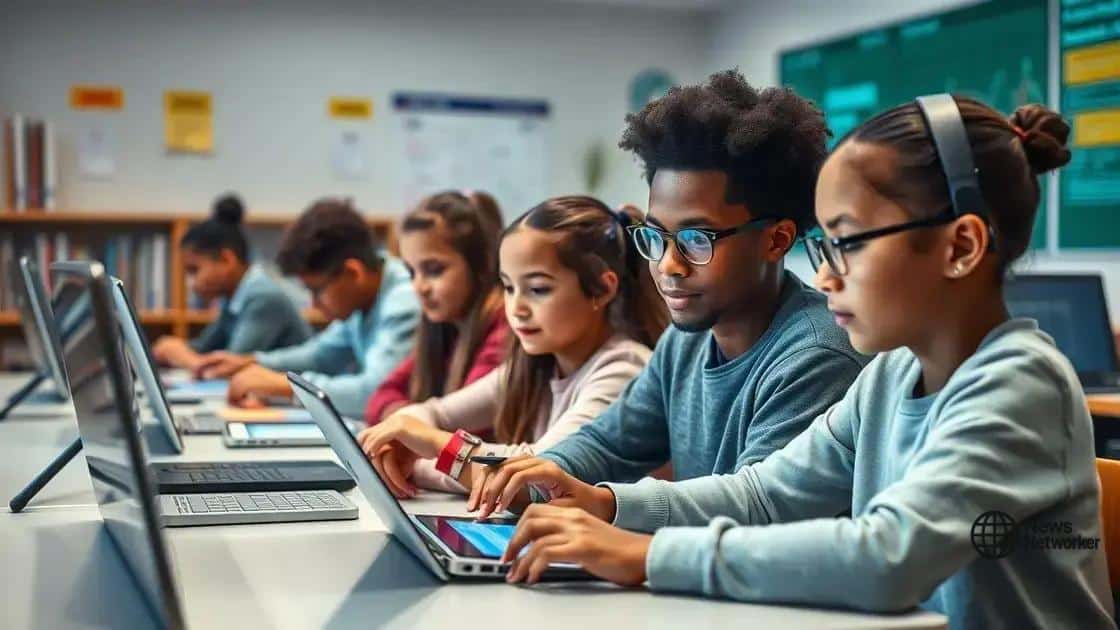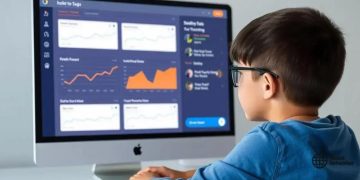Post-pandemic technological innovations in education

Post-pandemic technological innovations in education include increased accessibility, gamified learning experiences, and data-driven insights that personalize education and enhance student engagement.
Post-pandemic technological innovations in education have reshaped how we approach learning today. As schools and institutions adopt new tools, have you wondered how these changes affect students and teachers alike?
Embracing remote learning technologies
As education evolves, embracing remote learning technologies has become essential. Schools are integrating tools that enhance student engagement and accessibility. This shift not only benefits students but also teachers by providing innovative methods to deliver content.
Types of Remote Learning Technologies
Various technologies play a crucial role in remote learning. These include platforms for video conferencing, educational apps, and online course materials. By utilizing these technologies, teachers can create a more interactive and dynamic learning environment.
- Video conferencing tools like Zoom and Microsoft Teams
- Educational platforms such as Google Classroom and Canvas
- Asynchronous learning resources like Prezi and Edpuzzle
- Collaboration tools including Padlet and Slack
Furthermore, remote learning technologies support students’ varying needs. For instance, many platforms now offer features such as screen readers and closed captioning, making them accessible to all learners. This inclusivity is vital in fostering a positive learning experience.
Benefits of Remote Learning
The flexibility offered by remote learning technologies has transformed how education is delivered. Students can learn at their own pace, allowing them to absorb information without the pressure of traditional classroom settings. This approach encourages deeper understanding and retention of material.
Additionally, instructors are discovering new ways to enhance their teaching methods. With remote learning technologies, teachers can incorporate multimedia resources, encouraging creativity and engagement. For example, using interactive videos or virtual simulations makes lessons more appealing and memorable. This trend is reshaping educational practices for the better.
Lastly, embracing these technologies prepares students for future careers. In a world where remote work is becoming increasingly common, familiarizing students with these tools is essential. They develop vital skills that will serve them in any professional environment.
Impact of virtual reality in education
The impact of virtual reality in education is transforming how students learn and interact with content. Virtual reality (VR) offers immersive experiences that enhance understanding, making complex concepts more accessible.
Enhancing Engagement
One of the most significant benefits of virtual reality is its ability to engage students. With VR, learners can explore new environments, such as historical sites or intricate scientific landscapes, without leaving the classroom. This hands-on experience can boost motivation and interest in subjects.
- Experiencing historical events firsthand
- Exploring the human body in 3D biology lessons
- Simulating real-world problem-solving scenarios
- Traveling to far-off places for cultural studies
Moreover, VR helps cater to different learning styles. Visual learners can grasp information better through vivid imagery, while kinesthetic learners benefit from interactive experiences. This adaptability makes VR a powerful educational tool.
Promoting Collaboration
Another notable aspect of VR in education is the promotion of collaboration among students. Through shared virtual spaces, learners can work together on projects, regardless of physical distance. This collaboration fosters teamwork and communication skills essential for modern work environments.
Classrooms using VR technology frequently see increased participation and cooperation. Students can join forces in virtual scenarios, encouraging peer learning while tackling challenges as a team. This experience enriches the overall educational process.
Additionally, educators can utilize VR for professional development. Teachers can observe best practices in a virtual setting, allowing them to refine their skills and teaching strategies. This ongoing learning improves the quality of education as a whole.
Leveraging AI for personalized learning

Leveraging AI for personalized learning is revolutionizing education by tailoring experiences to meet individual student needs. With technology advancing at a rapid pace, educators are finding innovative ways to enhance learning outcomes.
What is Personalized Learning?
Personalized learning focuses on adapting educational experiences according to each student’s learning style, pace, and interests. This approach empowers students to take charge of their own learning, creating a more engaging environment.
- Adapting content to fit learning speeds
- Providing resources based on individual interests
- Offering real-time feedback and assessments
- Encouraging self-directed learning opportunities
AI technologies play a crucial role in delivering these personalized experiences. For example, intelligent tutoring systems can analyze student performance and suggest tailored resources, ensuring learners receive the support they need.
Benefits of AI in Education
By using AI, educators can gain insights into student behaviors and challenges. This data helps instructors create effective teaching strategies. Furthermore, AI-driven tools can automate administrative tasks, giving teachers more time to focus on instructional activities. This efficiency improves overall educational quality.
Moreover, AI enhances accessibility in education. With features like speech recognition and text-to-speech, students with different abilities can engage more fully in their studies. This inclusivity further exemplifies the power of AI in fostering equitable learning environments.
As schools increasingly adopt AI tools, students can enjoy a more personalized pathway to success. By merging technology with traditional teaching methods, the educational landscape is evolving, allowing for richer and more meaningful learning experiences.
The rise of gamification in teaching
The rise of gamification in teaching has transformed the educational landscape, making learning more engaging and effective. By incorporating game-like elements into lessons, teachers can motivate students and enhance their learning experiences.
What is Gamification?
Gamification refers to the use of game design concepts in non-game contexts. In education, this means applying elements like points, levels, and rewards to learning activities. By doing so, students become more invested in their education, viewing challenges as fun opportunities rather than just assignments.
- Progress tracking through points and badges
- Collaborative challenges that build teamwork skills
- Competition that encourages motivation and engagement
- Interactive scenarios that apply real-world skills
This innovative approach has shown positive results. Students often exhibit increased participation and enthusiasm for their work. Additionally, gamification promotes critical thinking and problem-solving skills, as learners navigate challenges and devise strategies to succeed.
Benefits of Gamification in Education
Integrating gamification into lessons also facilitates a more personalized learning experience. Teachers can tailor activities to meet different learning styles and paces. For instance, some students thrive on competition, while others benefit from collaborative tasks that promote social interaction.
Moreover, gamification enhances retention. When students engage with materials through games, they are likely to remember concepts longer. This method transforms information from passive learning into active participation, ensuring that knowledge sticks.
As technology continues to advance, educators are increasingly finding new ways to incorporate gamified elements into their curricula. Tools such as educational apps and online platforms make it easier than ever to implement these strategies, benefiting both students and teachers.
Trends in educational apps and platforms
Trends in educational apps and platforms are shaping the future of learning. As technology evolves, these tools are becoming more sophisticated, offering innovative ways to engage students and enhance their learning experiences.
Increased Accessibility
One significant trend is the emphasis on accessibility. Educational apps now often include features that support diverse learning needs. For example, apps may offer text-to-speech functions, adjustable text sizes, and customizable interfaces. These features ensure that all students can participate fully in their education.
- Speech recognition for hands-free learning
- Multilingual support for diverse classrooms
- Customizable learning paths based on student progress
- Interactive environments that cater to different learning styles
Moreover, platforms are incorporating gamified elements that make learning more engaging. Through badges, points, and leaderboards, students are motivated to participate actively and take charge of their own learning journey.
Data-Driven Insights
Another trend is the use of data analytics to provide insights into student performance. Educators can track progress in real-time, allowing them to adapt their teaching methods. By analyzing data from educational apps, teachers can identify which concepts students struggle with and modify their lessons accordingly.
This data-driven approach also helps personalize learning experiences. Students receive immediate feedback, which is essential for mastering new skills. As a result, students can progress at their own pace, reinforcing their understanding of material.
Additionally, many educational platforms now focus on collaboration. Features allowing students to work together on projects, share resources, and communicate in real-time promote teamwork and social skills. This shift prepares students for real-world applications where collaboration is key.
FAQ – Frequently Asked Questions about Educational Apps and Platforms
What are educational apps?
Educational apps are software applications designed to facilitate learning and enhance the educational experience for students of all ages.
How do gamification elements improve learning?
Gamification elements like points, badges, and challenges make learning more engaging, encouraging students to participate actively and enjoy the process.
Why is accessibility important in educational technology?
Accessibility ensures that all students, regardless of their abilities, can engage with learning materials. This promotes inclusivity and equal opportunities in education.
How can data analytics benefit teachers?
Data analytics helps teachers track student progress, customize lessons, and identify areas where students may need additional support, ultimately leading to better educational outcomes.





